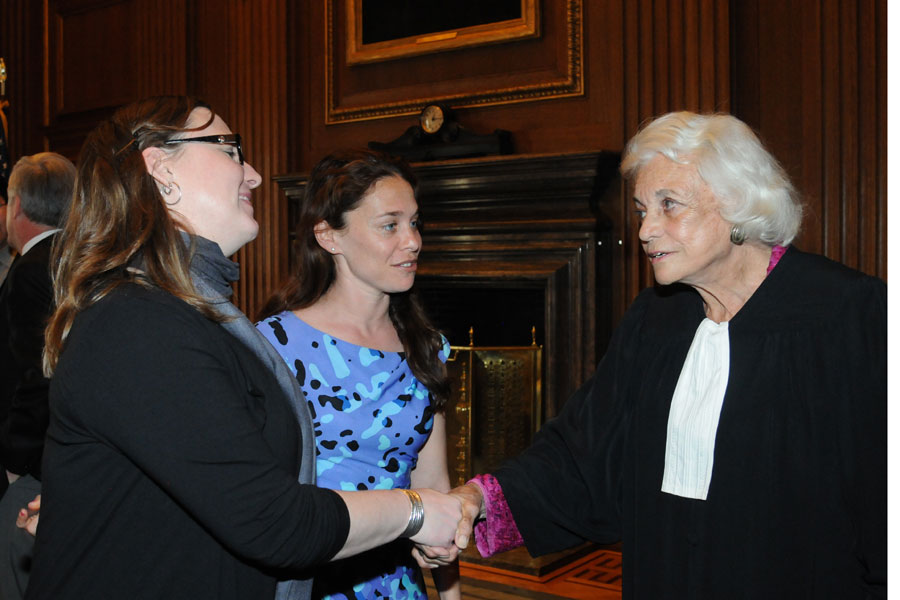Fine Furniture: Hobbs’ Reproductions Echo 18th Century

Perquimans County cabinetmaker Ben Hobbs pauses while standing on a floor covered with sawdust, and explains that it takes patience to make furniture the old-fashioned way.
“You can’t cross the line,” says Hobbs while locking at the back of a student’s unfinished Chippendale chair. “A piece is not done until it is right.”
In his classes for aspiring cabinetmakers, Hobbs teaches students how to use hand tools, traditional techniques and designs from the 18th century.
“There was a big group of furniture makers here in Perquimans County,” says Hobbs. “They didn’t make backwater furniture here. It was a takeoff on the Chippendale style in England.”
In the classes, students learn how to make fine American reproductions — from Chippendale chairs to pencil post beds. “Chippendale” applies to much of the well-made English furniture of the 18th century.
“My furniture is definitely English style — neat and plain, but this doesn’t mean there is no ornamentation,” says Hobbs. “Some pieces have carved feet.”
Hobbs’ classes are held in an old building within a complex in rural northeastern North Carolina between Hertford and Edenton. The workshop, which offers the aroma of new wood, is filled with a woodstove and numerous tools, clamps and unfinished pieces of furniture.
While taking the classes, students stay in fully restored pre-Civil War cottages moved from Gates and Perquimans counties. The 16 buildings — which include his home, the cottages, a smokehouse, milk house, jail and restaurant open for dinner to the public — are furnished in antiques and period pieces made by Hobbs.
For example, the red-sided Bennetts Creek House was built around 1750 and has modern conveniences. The cottage is decorated early American style with blue wainscoting and a pencil post bed, wing chair, high boy and armoire — all made by Hobbs. The floor is made of the original, wide-plank heart pine boards. The winding stairs lead to a loft bedroom with timbered beams, a twin bed and chest of drawers.
“The students can go back after class and examine the furniture and compare it to what they are making,” he says. “Being around the pieces makes the students appreciate this style of furniture more.”
Over the years, Hobbs has developed a reputation as an expert in early-American reproductions. He has conducted workshops at the N.C. Museum of History and for the American Period Furniture Makers.
“Ben is a true handcrafter,” says Patricia Marshall, curator of furnishings and decorative arts at the N.C. Museum of History. “He is making sure the lost art of cabinetmaking survives into the 21st century.”
Albemarle Region’s Furniture Heritage
During the 1700s, Perquimans County was one of the most prolific rural producers of furniture in eastern North Carolina and southeastern Virginia, according to Marshall.
Thomas White was one of the county’s most well-known cabinetmakers.
Thomas White established himself early on “says Marshall, “There was a trade route along the Chowan River that he followed.”
White’s style of furniture was tasteful and stylish and without the excessive details of French furniture that had a lot of foliage and scrolls, she adds.
One of White’s pieces was a walnut desk that was made for Thomas Newby of Belvidere Plantation in Perquimans County.
“The desk shows a strong link between the Albemarle and New England region,” says Marshall. “Its block and shell interior is similar to 18th-century furniture from Newport, Rhode Island.”
This dominance of trade between New England and North Carolina continued through the American Revolution, according to Ben Hobbs’ son, Matthew Hobbs, who wrote a thesis on the trade relationship while he was a fellow at the Winterthur Museum in Delaware.
Also, many Englanders settled in northeastern North Carolina.
“Importantly, the bonds between the Quaker communities in Perquimans County, North Carolina, in southside Virginia, in Rhode Island and elsewhere in the colonies provided a conduit for trade and cultural exchange, involving correspondence, intervisitation and even intermarriage,” he writes. The religious and mercantile connections between the Albemarle and other regions also contributed to sophistication in furniture production, according to Matthew Hobbs.
Sharrock Family
In neighboring Bertie County, the Sharrock family designed furniture from the late 1700s to 1800s.
“The Sharrock furniture was from the Roanoke River Basin School — neat, plain and straightforward — because that is what people preferred in this region and in Virginia,” says Marshall. “They didn’t use carvings on furniture like in Philadelphia and Rhode Island.”
Sharrock furniture is highly sought after by collectors because many of the pieces were sold during the Depression to northern collectors, according to Marshall.
In 2002, the N.C. Museum of History bought a china press — used to store ceramics and other household items — for $45,000, she adds.
The Roanoke River region also was home to a mystery cabinetmaker, “WH,” who carved his initials on pieces.
“His initials have been found on many pieces, but historians have never been able to identify who WH was,” according to Marshall. “He did neat and plain style and blockings, suggesting that he was a German American. WH also used distinct carvings over raised panel and black substance to imitate ebony. His initials were inlaid in white putty.”
From 1785 to 1795, WH made a lot of furniture with Masonic symbols and squares.
WH’s furniture has become quite valuable.
“A bookcase by WH sold for around $98,000 in New York City,” adds Marshall.
By the early 1800s, cabinetmakers had almost died out in northeastern North Carolina.
“From 1840 to 1850, there was a shift of cabinetmaking to the Piedmont and western part of the state,” adds Marshall.
Restoration Efforts
Hobbs’ furniture business evolved when he and his wife, Jackie Hobbs, developed an interest in old buildings.
While working as math teachers in Perquimans County during the 1970s, the couple found a 1700s home on a neighboring property and moved it to the family farm.
That first acquisition was the Pratt House, a two-story home that required three years of renovation and now is used as their home and an office for the Beechtree Inn.
Gradually, they began to add to the complex.
“I got interested in early houses and then started repairing antiques,” says Hobbs. “Building reproductions was a natural progression. Then I began studying the style of furniture here in Perquimans County.”
After a few carpentry and woodworking classes, Hobbs left his teaching job and began his cabinetmaking career. Over the years, he has made hundreds of pieces of furniture — from tables that sell for $500 to chests of drawers that sell for up to $5,000.
“I learned about furniture making mostly from reading books,” he says. “I collected good furniture and used it as examples. If I study a piece, I can tell how to make a copy.”
In 1994, the Hobbs family opened the Beechtree Inn as a bed and breakfast where guests stay in cottages.
A year after that, he started the school for aspiring furniture makers. The classes are for all skill levels. Five to eight students per class learn how to use hand planes, scrapers, rasps, handsaws and a host of tools.
Tim Schreiner, then editor of Fine Woodworking magazine, completed a Chippendale-style chair class.
“Hobbs is a natural teacher with an easy smile and a just-firm-enough approach to woodworking,” says Schreiner in the October 1999 issue of Fine Woodworking.
Because of the large number of historic buildings, restoration of the Hobbs’ complex is ongoing. Several buildings, including the jail, aren’t finished.
While showing the jail, Jackie Hobbs says that the studs are close together to prevent a person from getting through the bars. “There also is a four-inch subfloor that kept prisoners from getting out,” she adds.
Presently, the couple is renovating two houses from the 18th century and one from the early 19th century.
“It is very time consuming,” she adds. “It took us three years to restore the restaurant.”
Furniture Class
To get to the Hobbs complex, turn off N.C. 17 north to Hertford onto Snug Harbor Road. The road is flat with endless farm fields and little traffic. The only sign of life is a country store and church at the end of the road.
Turn the corner and the complex is on 30 acres next to his family’s farm.
His workshop is in a building behind his home.
During a recent class, Hobbs, sporting a plaid shirt and green apron, gives a lesson in cutting a mortise and tenon for a joint on the back of a chair.
“You cut it to the width and then to the length,” he says. “Then find the center line.”
After the demonstration, Hobbs shows his two students the back of a finished cherry and walnut chair.
“This is not angled,” he says while pointing to the splat that is shaped so that it is thinner than parts in the front of the chair. While teaching a class, Hobbs always works on a piece alongside his students.
“Every time I do a class I make a chair,” says Hobbs. “I teach four or five classes a year.”
Most of the students make furniture as a hobby.
“This is my first woodworking class,” says Curt Ivey, who works for the U.S. Navy in Virginia. “It is a jump in my skill level. I promised my wife that I would make her a set of chairs.”
The class is intense — running from 8 a.m. to 6 p.m. Monday through Friday and a half day on Saturday. The students break at lunch, when they walk across the yard to the restaurant in the complex. They eat lunch together at a large table in the restaurant decorated in an early American style with a black-and-white checkered floor and Hobbs’ fine reproductions.
“I painted the floor,” says Hobbs. “I made every piece of furniture in the restaurant but the bench and highchair.”
After lunch, the students smooth the edges of the backs of their unfinished chairs.
Then Hobbs gives step-by-step instructions in cutting out a pattern for the back of the chair, including marking the pattern on the wood.
“You always work from the center with a pattern,” says Hobbs. “You have to use a pattern with a chair and make it reasonably close to the pattern.”
Then Hobbs shows the students how to pierce out a hole with a saw.
“You need to saw everything at a 90-degree angle,” he adds.
After the demonstration, the students use the saw to cut a piece of wood.
Hobbs, who is a perfectionist, eyes every inch of their work.
“You want gentle curves and no bulges,” says Hobbs. “You need to work from the back.”
By the end of the week, the students have graceful Chippendale chairs for their homes.
Ivey learned so much in the class that he is coming back for an armchair class.
“I thought I was a good woodworker, but Ben’s knowledge of making furniture is almost overwhelming,” says Ivey. “In the old days, I would have been called an apprentice. Ben would have been the master who was passing on his skills.”
This article was published in the High Season 2005 issue of Coastwatch.
For contact information and reprint requests, visit ncseagrant.ncsu.edu/coastwatch/contact/.
- Categories:


